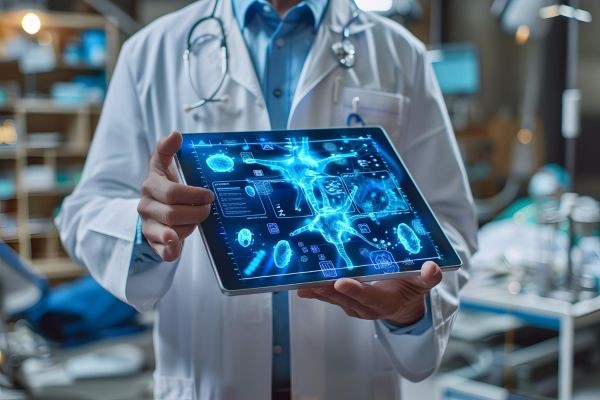Clarity is crucial in the ever changing field of medical technology. High-resolution images are essential to accurate diagnosis and can make the difference between a correct diagnosis and an error. Is it possible for a camera to significantly alter the diagnostics landscape? The response seems to be a resounding yes, especially with the introduction of 4K USB cameras in medical devices.
Integrating a 4K USB camera into diagnostic equipment is helping medical professionals across the globe capture finer details, enabling faster and more reliable diagnoses. This article delves into how these advanced cameras are addressing pain points for healthcare providers, improving patient outcomes, and elevating the diagnostic experience.
The Need for High-Resolution Imaging in Medical Diagnostics
From imaging scans to telemedicine consultations, today’s medical field is more reliant on visual data than ever before. Physicians and specialists need reliable tools that provide exceptionally clear visuals, especially when examining delicate or intricate areas. A 4K USB camera—capable of capturing images at four times the resolution of standard HD—delivers the detail needed for such tasks.
Many traditional cameras used in diagnostics are constrained by lower resolution, which can blur critical details. This gap in visual clarity means that certain symptoms, abnormalities, or features may go undetected, delaying or complicating the diagnostic process. By integrating 4K USB cameras, healthcare providers are equipped with a tool that ensures sharper, more precise images, minimizing the likelihood of missing key details.
Addressing Patient and Provider Pain Points
The need for higher diagnostic accuracy is central to improving patient outcomes and alleviating the pain points felt by healthcare providers and patients alike.
-
Limited Detail in Imaging: Lower-resolution cameras often leave much to the interpretation of the healthcare professional. This lack of detail can lead to potential diagnostic errors, requiring additional testing or more invasive procedures, both of which are taxing for patients.
-
Increased Procedure Time and Costs: When clarity is compromised, procedures can take longer as professionals try to gather additional visual information or use alternative, often costlier, diagnostic methods. This results in higher costs and a more cumbersome experience for both patients and providers.
-
Risk of Incomplete or Delayed Diagnosis: When diagnostic images are unclear, medical professionals may struggle to detect early-stage conditions. This lack of clarity could lead to delayed or even incomplete diagnosis, affecting patient outcomes and leading to further patient distress.
By integrating 4K USB cameras into medical diagnostic devices, these pain points can be addressed directly. Such cameras provide the high-resolution imagery needed for timely, accurate diagnosis, reducing the need for additional procedures and allowing healthcare providers to deliver more efficient and accurate care.
Key Applications of 4K USB Cameras in Medical Devices
The benefits of 4K USB cameras extend across various branches of medical diagnostics. Here’s a look at some of the primary applications where these advanced imaging devices are making a significant impact.
1. Microscopy and Pathology
Microscopes are crucial in diagnosing diseases at a cellular level, from identifying cancer cells to examining biopsies for infections or other abnormalities. In these applications, every pixel counts. A 4K USB camera allows pathologists to observe samples with an unprecedented level of clarity, capturing even the smallest cellular structures.
With sharper imaging, pathologists can make faster, more accurate assessments and communicate findings more effectively with other healthcare providers. These cameras also facilitate the storage of high-resolution digital slides, which can be reviewed by multiple experts across different locations, enabling collaborative diagnosis without the need for physical samples.
2. Ophthalmology
Ophthalmology is a field where precise imaging is essential. Diagnosing retinal diseases, glaucoma, or macular degeneration relies heavily on detailed images of the eye’s interior. A 4K USB camera integrated into ophthalmic equipment provides high-resolution images of the retina, optic nerve, and other critical areas, enabling eye specialists to detect early signs of disease and monitor progression with greater accuracy.
This technology aids in patient education as well, allowing doctors to show patients clear, detailed images of their eyes and explain conditions in a more accessible way. By bridging the gap between medical terminology and visual understanding, patients are more empowered in their healthcare journey.
3. Dermatology
Skin conditions are diverse, ranging from benign moles to more severe cases like melanoma. Dermatologists often require clear, close-up images to accurately assess and track skin changes. With a 4K USB camera, dermatologists can capture highly detailed images of the skin's surface, helping them distinguish between various textures, colors, and patterns associated with skin disorders.
This added detail minimizes the chances of misdiagnosing or overlooking subtle signs, leading to faster intervention when necessary. The camera’s high-definition imaging is particularly valuable for teledermatology, where remote diagnosis relies entirely on the quality of visual data received.
4. Surgical Assistance and Documentation
Surgical procedures demand exceptional clarity, particularly for minimally invasive techniques. With a 4K USB camera, surgeons gain a more detailed view of the operative field, enhancing their ability to perform precision work with confidence. These high-resolution cameras are especially valuable in endoscopic procedures, where space is limited, and the slightest detail can make a significant difference.
Beyond assisting in real-time, 4K USB cameras also improve documentation quality, allowing for better post-surgical analysis and teaching material. This technology enables surgical teams to review procedures with unprecedented detail, ensuring continuous improvement and training accuracy.
5. Telemedicine
In the age of telemedicine, clear visuals are indispensable for accurate remote consultations. 4K USB cameras in telemedicine devices provide detailed images of patients’ symptoms, enabling physicians to assess conditions as if the patient were physically present. For example, during a dermatology consult, a 4K camera can capture skin lesions with such detail that the physician can make a well-informed judgment remotely.
For patients, this means fewer in-person visits without sacrificing diagnostic quality, making healthcare more accessible and convenient, especially for those in remote or underserved areas.
How 4K USB Cameras Are Enhancing Patient Confidence
Integrating 4K USB cameras into diagnostic procedures not only enhances the clarity of medical images but also builds patient trust. When patients can see high-definition images and understand what the doctor is explaining, they are more likely to feel confident in their treatment plan.
For example:
- Reduced Anxiety: By sharing clear, high-resolution images of diagnostic findings, healthcare providers can demystify complex conditions, making it easier for patients to understand their diagnosis.
- Enhanced Transparency: Patients appreciate being shown concrete visual evidence. With 4K resolution images, doctors can walk them through the diagnostic process in an interactive and informative way.
- Faster Diagnoses: When a healthcare provider can make a definitive diagnosis faster, patients benefit from reduced wait times and quicker treatment paths, reducing the stress associated with long waits for answers.
The Future of Diagnostics with 4K USB Cameras
The integration of 4K USB cameras in medical devices marks a significant step forward in diagnostic imaging. As the technology continues to advance, we can expect even greater enhancements in diagnostic precision and efficiency. These cameras will likely evolve to incorporate artificial intelligence (AI), enabling automated analysis that could further enhance accuracy and speed up the diagnostic process.
Healthcare facilities are also moving towards more comprehensive data integration, where 4K images can be stored, analyzed, and shared across systems to ensure a seamless patient care experience. As these tools become more sophisticated and accessible, patients and healthcare providers alike will benefit from the exceptional clarity that only 4K USB cameras can provide.
Clear Vision for a Healthier Future
The adoption of 4K USB cameras in medical diagnostics is revolutionizing patient care. From pathology to telemedicine, these cameras are addressing long-standing challenges by offering unmatched clarity, precision, and efficiency. By investing in high-resolution imaging technology, healthcare providers can deliver faster, more accurate diagnoses, ultimately leading to better patient outcomes and a stronger foundation of trust.
As we look to the future, the demand for accurate, clear, and efficient diagnostics will only increase, making the role of 4K USB cameras in healthcare more indispensable. For both patients and providers, these devices represent a new era of diagnostic confidence and clarity, paving the way for a healthier future.


